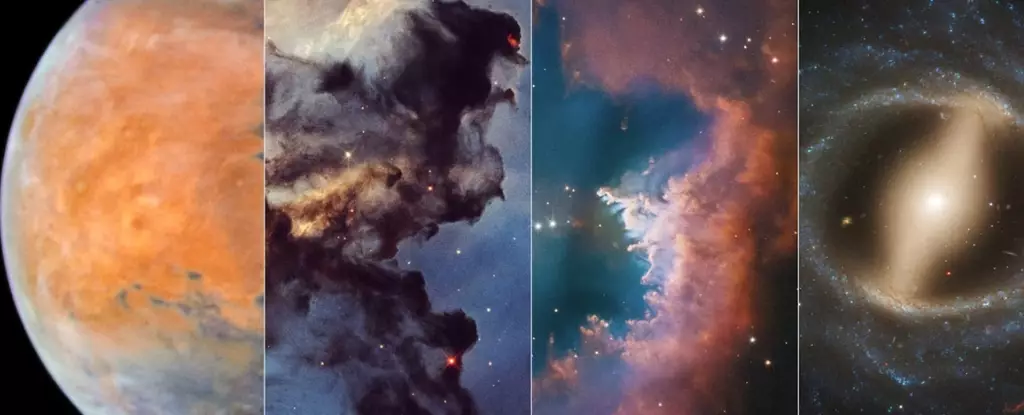This week marks a monumental occasion in the realm of astronomical exploration—the 35th anniversary of the Hubble Space Telescope’s launch. Rather than receiving gifts, NASA and the Space Telescope Science Institute have chosen to bestow upon us a series of awe-inspiring images showcasing the vastness of the universe. This annual tradition, commenced decades ago, highlights the telescope’s impact since its deployment on April 24, 1990, aboard the Space Shuttle Discovery. The images released this year provide breathtaking insights into our cosmic neighborhood, reminding us of the invaluable contributions Hubble has made to astronomy.
The significance of Hubble’s mission extends beyond mere observation. According to Shawn Domagal-Goldman, the acting director of NASA’s Astrophysics Division, Hubble has fundamentally altered our understanding of the universe. Its continued operation is a testament to the telescope’s remarkable design and engineering, which have allowed it to remain functional well past its initial expectations. This longevity serves as a crucial reference point as NASA looks toward future missions, including the upcoming Habitable Worlds Observatory (HWO), which aims to seek out potentially habitable exoplanets—continuing Hubble’s legacy of exploration and discovery.
From Challenges to Triumphs
Despite its renowned status, Hubble’s journey was fraught with challenges. Upon its initial deployment, astronomers discovered a major flaw in its primary mirror that compromised image quality. The setback could have terminated the project right there, but human ingenuity prevailed. The first servicing mission in 1993, conducted by brave astronauts, repaired the optical issue, unveiling the telescope’s true potential. Since that pivotal moment, Hubble has led us to astonishing discoveries—everything from the existence of black holes to pivotal insights into dark energy and the early universe.
Now, after over 1.7 million observations and contributions to more than 22,000 research papers, the telescope has cemented its legacy as a beacon of hope and curiosity for the public. These figures reflect not only the telescope’s precision and capability but also its role in fostering a shared sense of wonder among people across the globe. The bittersweet reality of Hubble’s exceptional performance over the years serves as a reminder that such brilliance often comes with a price; the tragic loss of the Columbia shuttle crew in 2003 delayed vital repairs that could have ensured precisely maintained operations.
A Window into the Universe
The images released to commemorate this anniversary are powerful examples of Hubble’s scope. Among them, the vivid snapshots of Mars taken in late December showcase its captivating features: the Tharsis plateau, dormant volcanoes, and the wispy ice clouds hovering above the polar regions. Each pixel reveals a narrative, a fragment of our celestial neighbor’s history. In another remarkable image, the Rosette Nebula comes to life, illuminated by stellar winds and chemical reactions occurring miles away, providing a glimpse into a star-forming area that is 5,200 light years from Earth.
Hubble’s wide-reaching capabilities are exemplified in yet another recent photograph of the spiral galaxy NGC 5335. This dynamic image offers intricate details of a bar-shaped structure influencing gas flow and, consequently, the birth of new stars. Such images highlight not only Hubble’s technological mastery but also its role in revealing the interconnectedness of cosmic phenomena. Each photograph is not merely an artistic masterpiece but a scientific record that facilitates deeper understanding of the universe.
Shifting Paradigms in Space Exploration
As the scientific community continues to honor Hubble’s vast contributions, the emergence of the James Webb Space Telescope (JWST) signifies a pivotal shift in astronomical discovery. Launched in 2021, JWST boasts enhanced light-gathering capabilities and focuses primarily on infrared observations, contrasting with Hubble’s broader wavelength versatility. While JWST is set to unveil aspects of the universe previously obscured from our view, it also raises concerns about Hubble’s future.
Despite NASA’s hopes for Hubble to remain operational for a few more years, it is increasingly susceptible to unforeseen failures due to the effects of aging technology and the harsh conditions of space. This looming uncertainty fuels anticipation for the HWO, a mission designed with advance technology and future servicing in mind. With its targets set on identifying Earth-like planets in distant solar systems, the Habitable Worlds Observatory aims not just to expand our knowledge but potentially to illuminate the path toward understanding our place in the cosmos.
In this ongoing journey through the universe, Hubble lies at the heart of a transformative era in astronomy, inspiring future generations to pursue the mysteries of space with relentless curiosity and imagination. Through its 35 years, Hubble has not only broadened our horizons but also ignited a flame of hope that future observations will reveal even more profound truths about the cosmos.


Leave a Reply